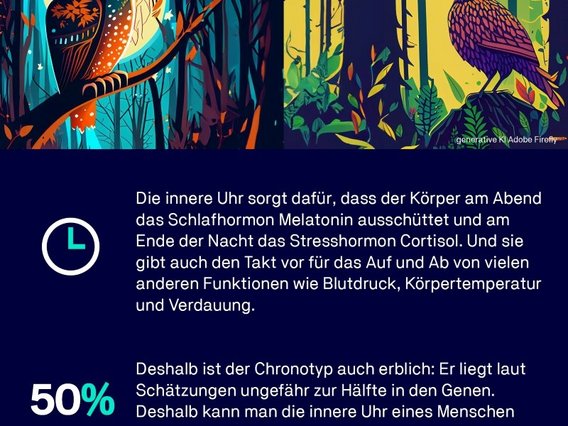Welcher Chronotyp bin ich?


Our internal clock determines when we get tired in the evening and wake up in the morning. Whether it ticks quickly or slowly is partly down to our genes. This is why a person's internal clock can even be read from their hair roots.
Morning people find it easy to start the day. They are already awake early in the morning and drive to work alert. Night people are still in a deep sleep - but they are at their best in the evening. In common parlance, the morning people are called “larks”, the night people “owls”. Experts speak of early and late “chronotypes”. Many people tend a little towards the early or late type, says Philip Frieg from the Medical-Psychological Institute of TÜV NORD in Dortmund. But only a few belong to the extremes: “Owls and larks are rare birds.”

Behind a person's chronotype is their internal clock: “It determines when we normally wake up in the morning and get tired in the evening,” explains the psychologist with a doctorate. It ensures that the body releases the sleep hormone melatonin in the evening and the stress hormone cortisol at the end of the night. And it also sets the pace for the ups and downs of many other functions such as blood pressure, body temperature and digestion.
“However, the internal clock ticks a little faster for the early type and a little slower for the late type,” reports Philip Frieg. The natural rhythm is not calibrated exactly to the length of the day, but to around 24 hours - more or less. Furthermore, the clock does not just follow its natural “circadian” rhythm, but adapts to the environment, especially the changes in light and darkness. The internal clock is a joint project: internal and external zeitgebers determine the rhythm together. And strictly speaking, there is not just one clock.
The central clock is located in the brain and is about the size of a grain of rice. It consists of many thousands of nerve cells, and millions of other cells in the body synchronize with it, for example in the skin and in the organs. Without a central clock, these cells would tick to the rhythm of their own small cellular clocks, directed by around a dozen genes in the cell nuclei. This is why the chronotype is also hereditary: according to estimates, around half of it lies in the genes.
How do I find out my chronotype?
These “clock genes” can now be used to determine your own chronotype using a single hair or blood sample. To do this, DNA messenger molecules are extracted from the hair root cells, which show how active certain genes are at any given time. Because these genes always peak in activity at certain times of day, researchers can draw conclusions about the chronotype.
If you want to determine the chronotype very precisely, the level of the sleep hormone melatonin in the blood is measured. In extreme morning or evening people, the level rises in the evening up to two hours earlier or later than average. However, measuring melatonin is very time-consuming because it requires taking several blood samples in the laboratory over the course of an evening.
It is easier to observe yourself, for example during a camping vacation in nature, when your body has had a few days to adjust to its natural rhythm without external constraints. Questionnaires can also help you to assess your chronotype on the basis of self-reports. When do I feel tired, when do I feel productive? When do I fall asleep on vacation, when do I wake up in the morning if I don't have to get up? When you “normally” go to bed and get up in everyday life is less meaningful. This is because it often depends on other things, such as when work starts in the morning or how late you are out in the evening.
There is no such thing as a “normal type”
According to self-assessments by more than 200,000 people, less than ten percent are early chronotypes and around 20 percent are late chronotypes: They fall asleep at least an hour and a half before or after the average. This average is around midnight on days off. According to the majority of respondents, they fall asleep between 11 pm and 1 am.
The fact that there are more morning grouches than morning people in Germany is mainly due to how much daylight people get in the morning. This also has to do with lifestyle. “Little daylight in the morning, then working from home during the day and artificial lighting in the evening: this shifts the chronotype backwards,” explains Philip Frieg from TÜV NORD. This is why there would be fewer late types without artificial light.
“The chronotype is not set in stone,” says the psychologist. It can change depending on your lifestyle, where you live, the time of year - and your age: children tend to wake up early. During puberty, the internal clock shifts up to two or three hours backwards. Adolescents have the “latest” chronotype at the age of 16 to 20; after that, the trend goes in the other direction again: as they get older, adults wake up earlier and earlier in the morning - and get tired earlier in the evening.
Philip Frieg recommends paying attention to the body's signals. “When you were 20, you partied late into the night. At 60, you might prefer to meet for coffee.” But whatever your age: “When your body clock says good night, you should listen to it.”
Founded over 150 years ago, we stand for security and trust worldwide. As a knowledge company, we have our sights firmly set on the digital future. Whether engineers, IT security experts or specialists for the mobility of the future: in more than 100 countries, we ensure that our customers become even more successful in the networked world.